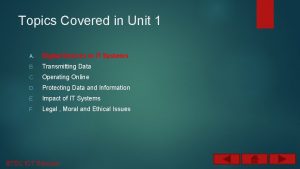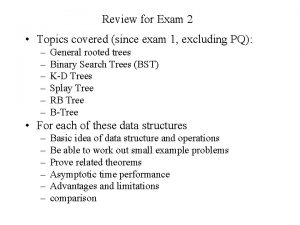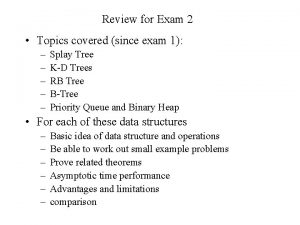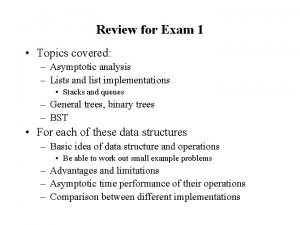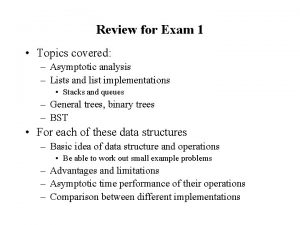Review for Exam 2 Topics covered since exam







- Slides: 7

Review for Exam 2 • Topics covered (since exam 1): – – – General trees Binary Search Trees (BST) Splay Tree K-D Trees RB Tree B-Tree • For each of these data structures – – – Basic idea of data structure and operations Be able to work out small example problems Prove related theorems Asymptotic time performance Advantages and limitations comparison

Review for Exam 2 • General tree – – Definition Internal and external nodes Height and depth, path length Tree storage methods and their nodes • Binary trees – Full, complete and perfect binary trees and their properties – 4 different orders of tree traversals

Review for Exam 2 • BST – Definition – Basic operations and their implementations • • • Find/contains, find. Min, find. Max insert, remove, – Time performance of these operations – Problems with unbalanced BST (degeneration)

Review for Exam 2 • Splay tree – Definition (a special BST: balanced in some sense) – Rationale for splaying: amortized performance – Splay operation (bottom up) • Root • without grandparent • with grandparent: zig-zag and zig-zig – When to splay (after each operation) – What to splay with find/insert/delete operations – Amortized time performance analysis: what does O(m log n) mean?

Review for Exam 2 • K-D Trees – What K-D trees are used for • Multiple keys – How K-D trees differ from the ordinary BST • levels – Be able to do insert and range query/print

Review for Exam 2 • RB tree – Definition: a BST satisfying 5 conditions • Every node is either red or black. • Root is black • Each NULL pointer is considered to be a black node • If a node is red, then both of its children are black. • Every path from a node to a NULL contains the same number of black nodes. – Theorems leading to O(log n) worst case time performance • Black height • min and max # of nodes a RB tree with bh=k can have – Bottom-up insertion and deletion

Review for Exam 2 B-Trees – What is a B-tree • Special M-way search tree (what is a M-way tree) • Internal and external nodes • M and L (half full principle), especial requirement for root – Why need B-tree • Useful/advantageous only when external storage accesses required • Why so? • Height O(log. M N), so are performances for find/insert/remove – B-tree operations • search • insert (only insert to nonempty leaf, split propagation) • Remove (borrow, merge propagation, update ancestors’ keys ) • B-tree design (determining M and L based on the size of key, data element, and disk block)
